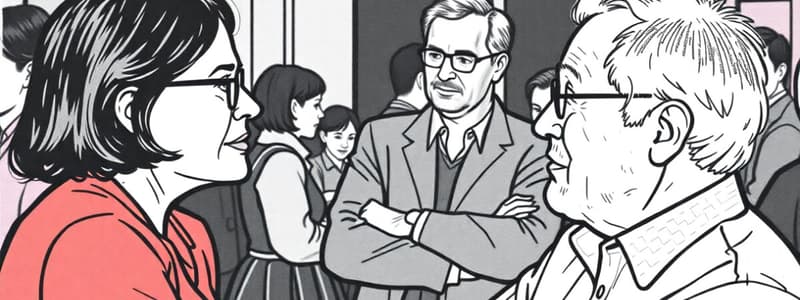Podcast
Questions and Answers
What is one of the primary reasons individuals cry at work, according to the conclusions drawn?
What is one of the primary reasons individuals cry at work, according to the conclusions drawn?
- They enjoy expressing their emotions openly
- They seek attention from their colleagues
- They are trying to share their feelings with others
- They are overwhelmed or bullied (correct)
According to Goffman, which concept suggests that there is no 'true self'?
According to Goffman, which concept suggests that there is no 'true self'?
- Presentation of self (correct)
- Emotional labor
- Feeling rules
- Social control
In Goffman's dramaturgical analysis, what term describes spaces where individuals can express emotions away from their audience?
In Goffman's dramaturgical analysis, what term describes spaces where individuals can express emotions away from their audience?
- Public arena
- Front stage
- Back stage (correct)
- Intimate space
What do 'feeling rules' indicate within emotional labor contexts?
What do 'feeling rules' indicate within emotional labor contexts?
Which statement reflects Soares' findings about the emotional responses of men in the workplace?
Which statement reflects Soares' findings about the emotional responses of men in the workplace?
What is the primary focus of symbolic interactionism as stated by theorists such as Herbert Blumer?
What is the primary focus of symbolic interactionism as stated by theorists such as Herbert Blumer?
Which concept describes the combination of multiple social positions that an individual holds?
Which concept describes the combination of multiple social positions that an individual holds?
Which statement most accurately describes ascribed status?
Which statement most accurately describes ascribed status?
In the context of role performance, which term refers to the expected behaviors associated with an individual's social position?
In the context of role performance, which term refers to the expected behaviors associated with an individual's social position?
What defines a master status in a social context?
What defines a master status in a social context?
What do the terms 'role strain' and 'role conflict' signify in social interactions?
What do the terms 'role strain' and 'role conflict' signify in social interactions?
Which of the following works is associated with Erving Goffman and focuses on everyday social interactions?
Which of the following works is associated with Erving Goffman and focuses on everyday social interactions?
According to Goffman, how does the concept of 'presentation of self' manifest in social interactions?
According to Goffman, how does the concept of 'presentation of self' manifest in social interactions?
Which of the following factors is not typically associated with achieved status?
Which of the following factors is not typically associated with achieved status?
Which example best represents a voluntary master status?
Which example best represents a voluntary master status?
What characterizes a total institution according to Goffman?
What characterizes a total institution according to Goffman?
Which of the following best describes role distancing?
Which of the following best describes role distancing?
What is the primary focus of ethnomethodology?
What is the primary focus of ethnomethodology?
What are breaching experiments intended to illustrate?
What are breaching experiments intended to illustrate?
What is meant by 'secondary adjustments' in the context of role acceptance?
What is meant by 'secondary adjustments' in the context of role acceptance?
What is the primary function of emotional labor in the workplace?
What is the primary function of emotional labor in the workplace?
How does Erving Goffman's perspective influence Hochschild's conceptualization of emotions?
How does Erving Goffman's perspective influence Hochschild's conceptualization of emotions?
What does Hochschild mean by 'deep acting' in the context of emotional work?
What does Hochschild mean by 'deep acting' in the context of emotional work?
In Hochschild's analysis, what role do female flight attendants symbolize within the context of emphasized femininity?
In Hochschild's analysis, what role do female flight attendants symbolize within the context of emphasized femininity?
What percentage of jobs held by women in the United States involve substantial emotional labor?
What percentage of jobs held by women in the United States involve substantial emotional labor?
What is one psychological consequence of emotional labor as identified by Hochschild?
What is one psychological consequence of emotional labor as identified by Hochschild?
What misconception might passengers have regarding the career choices of female flight attendants?
What misconception might passengers have regarding the career choices of female flight attendants?
What was the methodology used by Angelo Soares and his team to study emotional labor in service professions?
What was the methodology used by Angelo Soares and his team to study emotional labor in service professions?
What is meant by the term 'idealization' in the context of Goffman's presentation of self?
What is meant by the term 'idealization' in the context of Goffman's presentation of self?
How does Goffman describe the relationship between 'sincere involvement' and 'cynicism'?
How does Goffman describe the relationship between 'sincere involvement' and 'cynicism'?
What does the concept of 'resocialization' specifically involve?
What does the concept of 'resocialization' specifically involve?
Which of the following best describes a 'total institution' according to Goffman?
Which of the following best describes a 'total institution' according to Goffman?
In terms of Goffman's analysis, what role does 'saving face' play in social interactions?
In terms of Goffman's analysis, what role does 'saving face' play in social interactions?
What can be inferred about Goffman's concept of the 'front' and 'backstage'?
What can be inferred about Goffman's concept of the 'front' and 'backstage'?
Which of the following professions is considered to carry 'special status' in Goffman's analysis?
Which of the following professions is considered to carry 'special status' in Goffman's analysis?
What does Goffman's example of 'manager mobbing' illustrate?
What does Goffman's example of 'manager mobbing' illustrate?
Flashcards
Symbolic Interactionism
Symbolic Interactionism
A sociological perspective emphasizing how social interaction shapes meaning and understanding of the world.
Social Status
Social Status
A position within a social hierarchy, defining a person's place in society.
Social Role
Social Role
Expected behaviors associated with a specific status; how people act in various social positions.
Status Set
Status Set
Signup and view all the flashcards
Role Set
Role Set
Signup and view all the flashcards
Ascribed Status
Ascribed Status
Signup and view all the flashcards
Achieved Status
Achieved Status
Signup and view all the flashcards
Master Status
Master Status
Signup and view all the flashcards
Presentation of self
Presentation of self
Signup and view all the flashcards
Goffman's view on social interactions
Goffman's view on social interactions
Signup and view all the flashcards
Total Institutions
Total Institutions
Signup and view all the flashcards
Role Distancing
Role Distancing
Signup and view all the flashcards
Ethnomethodology
Ethnomethodology
Signup and view all the flashcards
Breaching Experiments
Breaching Experiments
Signup and view all the flashcards
Secondary Adjustments
Secondary Adjustments
Signup and view all the flashcards
Idealization
Idealization
Signup and view all the flashcards
Rationalization of motives
Rationalization of motives
Signup and view all the flashcards
Saving face
Saving face
Signup and view all the flashcards
Resocialization
Resocialization
Signup and view all the flashcards
Mortification of self
Mortification of self
Signup and view all the flashcards
Front/Backstage
Front/Backstage
Signup and view all the flashcards
Emotional Labor
Emotional Labor
Signup and view all the flashcards
Feeling Rules
Feeling Rules
Signup and view all the flashcards
Emotional Work (Deep Acting)
Emotional Work (Deep Acting)
Signup and view all the flashcards
Emotional Labor in Jobs (US)
Emotional Labor in Jobs (US)
Signup and view all the flashcards
Goffman's Influence on Hochschild
Goffman's Influence on Hochschild
Signup and view all the flashcards
Hochschild's Emotional Work View
Hochschild's Emotional Work View
Signup and view all the flashcards
Emphasized Femininity
Emphasized Femininity
Signup and view all the flashcards
Service Industry
Service Industry
Signup and view all the flashcards
Backstage
Backstage
Signup and view all the flashcards
Dramaturgical Analysis
Dramaturgical Analysis
Signup and view all the flashcards
Forced Resocialization
Forced Resocialization
Signup and view all the flashcards
Study Notes
Foundations of Sociological Thought
- Symbolic interactionism is a theoretical perspective emphasizing the role of symbols and interactions in shaping human behavior.
- Key figures in symbolic interactionism include Herbert Blumer, Erving Goffman, and Arlie R. Hochschild.
- Blumer, Goffman, and Hochschild significantly contributed to the development and expansion of symbolic interactionism.
Symbolic Interactionism and Dramaturgy
- Herbert Blumer's work focused on social interaction.
- Erving Goffman's focus centered on dramaturgy, viewing social interaction as a performance.
- Arlie Hochschild explored emotional labor in the context of social interaction.
Actors Not By Our Own Choosing
- Shakespeare's quote highlights the stage-like nature of social life
- Wilde's view emphasizes flaws and unevenness in the social narrative.
Readings
- The Methodological Position of Symbolic Interactionism (1969)
- The Presentation of Self in Everyday Life (1959)
- Asylums (1961)
- The Managed Heart (1983)
Social Status and Social Roles
- Social life is structured by interactions between people with specific statuses.
- Social statuses are positions within the social hierarchy.
- Roles are the expected behaviors associated with specific statuses.
- Role strain and role conflict can arise when expectations conflict or are numerous.
Status Sets and Role Sets
- Individuals often hold multiple statuses simultaneously.
- A status set comprises all the statuses a person holds.
- A role set encompasses all the roles associated with a particular status.
- Each role has specific rights and duties.
Ascribed vs. Achieved Status
- Ascribed statuses are assigned based on inherent characteristics.
- Achieved statuses are earned through effort and personal choices.
- Social capital can impact the achievement of desired statuses.
Master Status
- Master statuses profoundly influence individuals’ lives, affecting their overall identities.
- Disability status is a frequent example in the study of master statuses
- Elected office (presidents) is a further example of voluntary master statuses.
What Statuses/Roles Do You Hold/Perform?
- Individuals consider current statuses and roles, identifying whether they are ascribed or achieved.
- Participants consider roles associated with both statuses.
- Individuals write down chosen statuses and roles for analysis.
The Reality of Social Interactions
- Social interactions are not always "natural" or purely based on objective reality.
- People construct meaning in their interactions.
Erving Goffman and the Presentation of Self
- Goffman (1922-1982) explored how individuals present themselves to others.
- Dramaturgy and everyday interactions.
- Goffman focused on social interactions, particularly how individuals construct their self-image to others.
- Performances and defined situations.
Key Terms
- Interactions are characterized by reciprocal influences in the immediate proximity of individuals
- A performance in any interaction involves all activities of a particular participant directed towards others.
- Parts and routines represent structured ways of behaving which arise from and within social roles.
The Definition of Situation
- Individuals constantly seek information and try to discern the situation when they encounter new people.
- Information gathering improves expectations about what to expect.
- This in turn generates a form of social script of what someone may do or expect.
Erving Goffman and the Presentation of Self 2
- Individuals actively attempt to create positive impressions on others (idealization).
- Motives are frequently rationalized to make interactions seem more intentional than just happenstance.
- Embarrassment and "saving face" are important to ensure smooth interactions.
- Individuals play out roles and utilize a back and front stage to maintain decorum
Erving Goffman and the Presentation of Self 3
- Individuals may act as if they have an ideal self to others, which is not how they might always act.
- Some social roles have special status and responsibility associated with them (doctors).
Resocialization
- Resocialization is the effort to change a person's attitudes and behaviors in a setting.
- This often occurs in a total institution.
- The transition into total institutional settings frequently leads to a form of forced resocialization.
Total Institutions
- Total institutions organize all aspects of individuals' lives.
- They often use standardized practices and approaches.
- Life in total institutions often involves strict schedules and rules.
Role Distancing
- Role distancing refers to when individuals engage in actions associated with a role but do not fully adhere to it.
- It is characterized as a form of social distancing.
- Secondary adjustments characterize unwillingness to adhere to role expectations.
Ethnomethodology
- Ethnomethodology studies how people interpret and make sense of social norms and interactions.
- Individuals frequently use preexisting shared norms and understandings to interpret or adhere to actions of others.
- Breaching experiments disrupt patterns of social interaction
Breaching Experiments
- Individuals purposefully disrupt everyday social interactions to illustrate the underlying assumptions.
- Observation of reactions can showcase the extent that interactions are built on assumptions.
Emotional Labor
- Hochschild introduced the concept of emotional labor in the 1970s.
- Emotional labor involves producing or suppressing emotions to meet job expectations.
- Significant amounts of emotional labor are required across numerous social roles (particularly feminine ones).
Goffman and Hochschild
- Goffman had a profound impact on Hochschild's conceptualization of emotions.
- Goffman's perspective highlights how interactions rely on particular emotional performances given the social setting.
Goffman and Hochschild 2
- Emotional work (deep acting) is important and significant, as are feeling rules and emotional labor.
- It plays several roles in shaping social interactions, creating and maintaining societal structures. (e.g. flight attendants).
- Emotional labor and feeling rules often influence interactions, resulting in both individual and collective psychological responses.
Emphasized Femininity
- Female flight attendants enact expectations and roles associated with womanhood, such as nurturing, caring, and sensitivity to others in their interactions and performances.
Emotional Labor in the Workplace
- Service-based jobs often involve significant emotional labor.
- Employees may experience stress from emotional labor.
Emotional Labor in the Workplace 2
- Research has shown that men are not immune to crying and feeling emotions over work, but the context of who it is in front of can change the overall behaviour shown. (e.g. back stage/ washroom versus front stage)
Discussion Questions
- How do feelings impact emotion, work, and emotional responses?
- What are the implications for individual identities?
- Social inequality and societal structures influence individuals.
Conclusion
- Social life is a form of enacted behavior, and individuals enact self-presentations within particular social contexts.
- Individuals strive to maintain order to avoid disruption from various social encounters.
- Elements such as emotional labor, feeling rules, and resocialization are frequently used to promote and maintain social control.
Studying That Suits You
Use AI to generate personalized quizzes and flashcards to suit your learning preferences.




